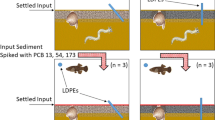Abstract
Purpose
Thin-layer caps (TLC) can be an effective method for managing in situ–contaminated sediments. However, there is very little information in the literature on the amount of mixing between the sediments and the applied cap material that should be estimated during design. This study examined the amount and extent of disturbance resulting from the placement of a cap material as evidenced by visual observations and verified with vertical chemical gradients profiles.
Materials and methods
Pollucite, a zeolite mineral tracer enriched with cesium, was entrained in the top 2 cm of the sediment surface by divers as a marker of the sediment-water interface prior to cap construction. Diver-collected cores were extracted 24–48 h after tracer application to determine the initial concentrations of pollucite. Post-cap construction, cores were collected from each of the test plots by divers during two subsequent sampling efforts, 4 months and 1 year after the tracer was applied to assess the degree of mixing. The cores were then split, photographed, and sectioned into 1 cm intervals which were analyzed for particle size distribution and a suite of trace metal elements including cesium.
Results and discussion
Each of the sectioned cores collected had a discrete and distinct visual interface between the original sediments and the cap material with no mixing observed which was consistent with the X-ray images. All the cores had a well-defined Cs signal/depth profile with only trace levels being detected in the samples of cap material that were in direct contact with sediment. This mixing zone, as determined by the Cs signal, was generally constrained to within 2 cm of the interface between the capping material and contaminated sediment and is consistent with the initial depth that the pollucite was entrained in the sediment. The chemical analyses also confirmed that there was no measureable transfer of mercury or other contaminants from the sediment to the cap material.
Conclusions
All lines of evidence indicate that there was very little disturbance or entrainment of the in situ sediments into the cap material in this study. While these results are specific to the site studied, some general insights and approaches to assess sediment disturbance during cap construction have resulted. This study has also successfully expanded the use of a tracer, such as pollucite, to assess the disturbance of in-place sediments during the construction of a thin-layer cap.










Similar content being viewed by others
References
AECOM (2012) Peninsula Harbour sediment remediation project: closure report, draft for discussion, September 2012
AECOM Environment (2009) Bathymetry and side scan survey in Jellicoe Cove. Consultant Report, 23 November 2009
Biberhofer J (2005) Application of an exotic mineral tracer to measure surficial sediment mixing layer depth and document sediment chronology. Conference Presentation, International Association for Sediment Water Science, Bled, Slovenia, 2005
Biberhofer J, Dunnett MP (2005) A report on the chemical and physical characteristics of the sediment in Jellicoe Cove, Peninsula Harbour. Environment Canada, NWRI Tech. Rep. No. AEMRB-TN05-002, National Water Research Institute, Burlington, Ontario, Canada
CCME (1999) Canadian sediment quality guidelines for the protection of aquatic life. Mercury. http://ceqg-rcqe.ccme.ca/download/en/241. Canadian Council of Ministers of the Environment
Coakley JP, Poulton DJ (1991) Tracers for fine sediment transport in Humber Bay, Lake Ontario. J Great Lakes Res 17:289–303
Environ International Corporation (2008) Sediment management options for Peninsula Harbour area of concern, Final Consultant Report
Graham M, Hartman E, He C, Droppo IG (2013) Examining thin layer cap behaviour in a freshwater industrial harbour. J Soils Sediments 13:1515–1526
Josefsson S, Schaanning M, Samuelsson GS, Gunnarsson JS, Ida Olofsson I, Eek E, Wiberg K (2012) Capping efficiency of various carbonaceous and mineral materials for in situ remediation of polychlorinated dibenzo-p-dioxin and dibenzofuran contaminated marine sediments: sediment-to-water fluxes and bioaccumulation in boxcosm tests. Environ Sci Technol 46:3343–3351
Loring DH (1991) Normalization of heavy-metal data from estuarine and coastal sediments. ICES J Mar Sci 48:101–115
Merritt K, Condor J, Mager V, Kirtay VJ, Chadwick BD (2009) Enhanced monitored natural recovery (EMNR) case studies Review. U.S Navy, Tech Rep No. 1983, SPAWAR Systems Center Pacific, San Diego, California, USA
Mudroch A, MacKnight SD (1994) In: Mudroch A, MacKnight SD (eds) Handbook of techniques for aquatic sediments sampling. CRC Press Inc., Boca Raton, FL, pp 29–95
NLET (2018) Nelac Method ID: B0402S. Standard operating procedure for the analysis of acid extractable metals in sediments, soil and air particulates by microwave digestion and inductively coupled plasma mass spectrometry. Environment and Climate Change Canada, National Laboratory for Environmental Testing, Burlington, ON, Canada
Acknowledgements
This study relied on the skills and dedication of our collegues who are divers with the Research Support Section, WSTD, Environment and Climate Change Canada. We are grateful to two anonymous reviewers for their critical review and comments whcich served to improve this manuscript.
Author information
Authors and Affiliations
Corresponding author
Additional information
Responsible editor: Gijs D. Breedveld
Electronic supplementary material
Supplementary Fig. 1
Diver laying out sample grid and application of pollucite slurry (JPG 27 kb)
Supplementary Fig. 2
Diver collecting core. Note the furrows in the sand created while entraining tracer with rakes (JPG 25 kb)
Supplementary Fig. 3
Setup for core x-rays (JPG 45 kb)
Supplementary Table 1
(DOCX 12 kb)
Supplementary Table 2
(DOCX 13 kb)
Supplementary Table 3
(DOCX 16 kb)
Supplementary Table 4
(DOCX 17 kb)
Supplementary Table 5
(DOCX 17 kb)
Supplementary Table 6
(DOCX 18 kb)
Rights and permissions
About this article
Cite this article
Biberhofer, J., Graham, M., Hartman, E. et al. Assessment of sediment disturbance during application of a thin-layer cap in Peninsula Harbor, Canada. J Soils Sediments 19, 1040–1052 (2019). https://doi.org/10.1007/s11368-018-2175-0
Received:
Accepted:
Published:
Issue Date:
DOI: https://doi.org/10.1007/s11368-018-2175-0




